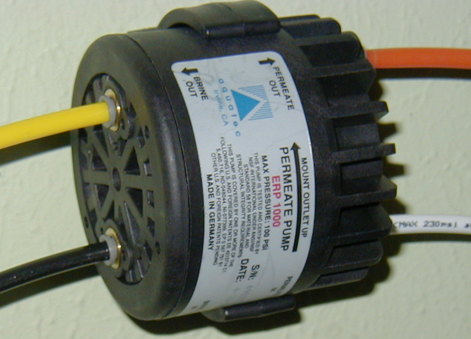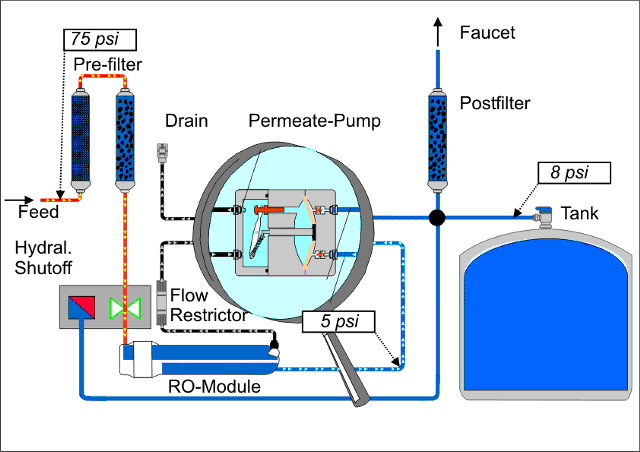How Permeate Pumps Work

Unlike electric pumps that boost inlet pressure to reverse osmosis units, the unique "permeate pump" enhances performance without actually providing additional pressure for the inlet side of the unit. The permeate pump, instead, greatly reduces the back pressure from the RO unit's storage tank. This allows the RO membrane to take full advantage of the pressure that it has.
Permeate is water treatment jargon for the product water of the reverse osmosis unit--water that has been treated by the membrane, the water you're going to drink. Brine is the rinse water, the water that is carrying away the impurities rejected by the membrane, the water that will ultimately go down the drain.
The pump works by storing the hydro power of the brine, the reject water, and using the energy to power the permeate under pressure into the unit's storage tank.
RO storage tanks in undersink units use air pressure to push water out of the faucet. With standard RO units, the unit must force the water into the storage tank. This robs it of pressure and thus efficiency. With permeate pump units, the pressure from the reject water is used to overcome this back pressure from the tank and to power the permeate into the storage tank.
The result is a quite remarkable increase in unit efficiency. Since the RO unit can fill the tank much faster without the hindrance of back pressure, far less reject water is used and the permeate, or product water, is purer.
Here's how the flow through the pump works, with reference to the picture above:
Brine In. Black Tube. Water leaves the membrane housing's brine port and goes to the pump, under pressure.
Brine Out. Yellow Tube. After providing power that is stored in the left side of the pump (think of it as winding a clock spring to store energy for later use), the brine exits and goes to the undersink drain pipe via the yellow tube.
Permeate In. White Tube. The permeate from the RO unit's membrane enters the right chamber of the pump. There is no back pressure. The permeate collects in this pressure-free chamber until the brine side of the pump releases energy and powers it out of the chamber.
Permeate Out. Orange Tube. Powered by the stored energy from the brine, the permeate water is forced into the unit's pressurized storage tank via the orange tube.
How The Pump Works
 |
|---|
For more about permeate pumps from our main website.
See also on this site, "The Amazing Permeate Pump," by Gene Franks.
And, by the way, when you talk about reverse osmosis units, don't display your lack of understanding by calling the brine "waste water." It isn't. The brine is as important a part of the RO final product as the permeate itself. The brine performs the essential function of carrying away the impurities and keeping the membrane clean. It isn't "wasted" any more than the water you wash your hair or or mop your floor with is wasted.
Say "waste water" once more and you'll feel this wrench on your knuckles. |